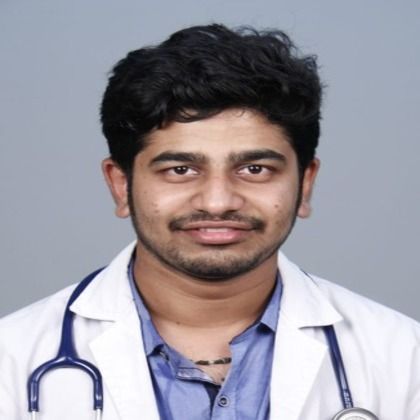Virus and Lung Tuberculosis: Causes, Risks, and Treatment Explained
Learn how viral infections impact lung tuberculosis. Read the article to know the causes, symptoms, diagnosis, and treatment of TB.

Written by
Last updated on 3rd Jul, 2025
Introduction
Lung tuberculosis (TB) is a serious bacterial infection that primarily affects the lungs but can also spread to other organs. You can contract it by inhaling airborne droplets expelled when an infected person coughs or sneezes. It is caused by Mycobacterium tuberculosis, which infects the lungs and can remain dormant (latent TB) or become active, leading to persistent cough, fever, night sweats, and weight loss. If untreated, TB can cause severe lung damage and respiratory failure.
Viruses are microscopic infectious agents that invade human cells and disrupt normal functions. Some viruses, like influenza, COVID-19, and HIV, weaken your immune system, making it harder for your body to fight infections. Chronic viral infections can increase your risk of developing TB or worsen its effects.
Viruses and TB are closely linked. HIV, for example, weakens your immune system, making latent TB more likely to become active. Other respiratory viruses, like influenza and COVID-19, can increase lung inflammation, which may worsen TB symptoms.
Understanding Lung Tuberculosis
Lung tuberculosis is the most common form of TB, affecting your lungs’ ability to function properly. The bacteria settle in the lungs, causing inflammation, lung tissue damage, and breathing difficulties. Understanding how TB spreads and its impact is crucial for prevention and control.
1. Causes and Transmission of Tuberculosis
TB spreads when an infected person coughs, sneezes, or talks, releasing bacteria into the air. You can get infected by inhaling these droplets. However, not everyone exposed to TB develops the disease—it depends on your immune system. People with HIV, diabetes, malnutrition, or weakened immunity are at higher risk.
2. How TB Affects the Lungs?
When TB bacteria enter your lungs, they cause:
Lung inflammation, making breathing harder.
Persistent cough, sometimes with blood.
Fluid buildup, leading to chest pain and reduced oxygen intake.
Progressive lung damage, which can lead to respiratory failure if untreated.
TB can also spread to other parts of your body, including the brain, kidneys, and bones.
3. Global Impact and Prevalence
Tuberculosis remains a global health challenge, with over 10 million new cases each year. The highest burden is in developing countries, where poor healthcare access and malnutrition contribute to TB’s spread. Drug-resistant TB is also rising, making treatment more difficult. Global efforts, such as vaccination programs and improved diagnostics, aim to reduce TB cases worldwide.
Viral Infections and Tuberculosis
Certain viral infections can increase your risk of developing active TB or worsen TB symptoms. Viruses like HIV, influenza, and COVID-19 impact your immune system, making it easier for TB bacteria to multiply. Understanding how viruses affect TB is essential for better disease management.
1. Common Viruses that Influence TB (e.g., HIV, Influenza)
Several viruses are known to interact with TB, including:
HIV – The most significant risk factor for TB. People with HIV are 20-30 times more likely to develop active TB.
Influenza – Seasonal flu weakens lung immunity, increasing TB risk.
COVID-19 – Causes lung damage and prolonged inflammation, making TB infections worse.
Measles and RSV – Affect immune responses, making TB progression more likely.
2. Mechanisms by Which Viruses Affect TB Progression
Viral infections can weaken lung immunity, making it easier for TB bacteria to spread. Here’s how:
Immune suppression – HIV destroys immune cells that keep TB under control.
Lung inflammation – Influenza and COVID-19 cause lung damage, making TB symptoms worse.
Delayed TB diagnosis – Viral infections mask TB symptoms, leading to late detection and treatment.
These mechanisms make it essential to monitor and treat viral infections in TB patients.
3. Case Studies and Research Findings
Research has shown that TB-HIV co-infection significantly increases TB mortality rates. Studies also reveal that patients with COVID-19 and TB have worse lung damage and longer recovery times. A recent study found that influenza vaccinations can reduce TB complications by strengthening immune defenses.
Newer research focuses on integrating TB and viral infection treatments to improve survival rates and reduce disease spread.
Risk Factors
Certain factors can increase your risk of developing lung tuberculosis (TB) or make the infection more severe. These include viral co-infections, weakened immunity, and environmental conditions. Understanding these risk factors can help you take preventive steps.
1. Co-Infection with Viruses
If you have a viral infection like HIV, influenza, or COVID-19, your risk of developing active TB is much higher. These viruses suppress your immune system, allowing TB bacteria to multiply. HIV-TB co-infection is particularly dangerous, as it speeds up TB progression and increases mortality rates.
2. Immunosuppression and Tuberculosis
A strong immune system keeps TB under control. But if your immunity is weakened due to cancer treatments, organ transplants, or chronic diseases (like diabetes), your body may struggle to fight TB bacteria. Malnutrition and stress can also lower your immunity, increasing TB risk.
3. Environmental and Lifestyle Factors
Where you live and how you live can also affect your TB risk.
Overcrowded spaces – TB spreads faster in prisons, refugee camps, and urban slums.
Poor ventilation – Enclosed spaces allow TB bacteria to linger in the air.
Smoking and air pollution – Damage lung tissues, making TB more severe.
Avoiding these risk factors can help reduce TB transmission.
Symptoms and Diagnosis
TB symptoms can develop slowly, making early detection difficult. Recognizing the warning signs and getting tested is essential for starting treatment on time.
1. Recognising Symptoms of Lung Tuberculosis
If TB is active in your lungs, you may notice:
Persistent cough – Lasting over three weeks, sometimes with blood.
Chest pain and difficulty breathing – Due to lung inflammation.
Fever and night sweats – Common signs of infection.
Fatigue and weight loss – TB weakens your body over time.
If you have co-infections (HIV, flu, or COVID-19), your TB symptoms may be more severe and progress faster.
2. Testing and Diagnosis Techniques
If your doctor suspects TB, they may recommend:
Tuberculin Skin Test (TST) – Checks for TB exposure.
Blood tests (IGRAs) – More accurate for detecting TB infection.
Chest X-ray or CT scan – Identifies lung damage or TB-related scarring.
Sputum Test – Confirms active TB by analyzing lung secretions for bacteria.
3. Importance of Early Detection
Diagnosing TB early prevents severe complications and reduces the risk of spreading the disease to others. If you experience persistent cough and fever, don’t wait—get tested immediately. Early treatment saves lives and stops TB from worsening.
Treatment and Management
TB is curable, but treatment must be strictly followed to prevent drug resistance. The standard regimen lasts 6 to 9 months, but if you have drug-resistant TB or co-infections, treatment may take longer.
1. Standard Anti-Tubercular Regimen
If you have drug-sensitive TB, your doctor will prescribe:
Isoniazid and Rifampin – The most effective TB medications.
Pyrazinamide and Ethambutol – Help clear bacteria and prevent resistance.
Skipping doses or stopping treatment early can lead to drug-resistant TB, which is harder to cure.
2. Managing Co-Infection with Viruses
If you have HIV, flu, or COVID-19 alongside TB, managing both infections is critical.
HIV-TB co-infection requires antiretroviral therapy (ART) alongside TB treatment.
Influenza or COVID-19 patients need symptom management while completing TB therapy.
Vaccination (flu, COVID-19) can help reduce complications in TB patients.
Managing both infections together ensures better recovery and fewer complications.
3. Monitoring Patient Progress
Regular medical follow-ups are essential to:
Check for drug resistance – If symptoms don’t improve, medication adjustments may be needed.
Manage side effects – TB medications can sometimes cause liver issues or nausea.
Prevent relapse – Completing the full course of TB treatment ensures a full recovery.
Following your doctor’s instructions strictly is the key to beating TB completely.
Preventive Measures
Preventing TB is just as important as treating it. By focusing on vaccination, public health efforts, and personal protection, you can lower your risk and help stop the spread of TB.
1. Vaccination Strategies
The BCG vaccine is widely used to protect against severe TB, especially in children. While it doesn’t prevent all TB cases, it reduces the risk of severe complications like TB meningitis. Researchers are also developing new TB vaccines to improve immunity in high-risk groups.
2. Public Health Initiatives
Governments and health organizations are working to reduce TB cases through:
TB screening programs for high-risk populations.
Free TB treatment to ensure accessibility.
Improved living conditions to prevent overcrowding and transmission.
These efforts are essential in controlling TB at a national and global level.
3. Personal Protection Strategies
You can protect yourself and others by:
Wearing a mask if you’re in close contact with TB patients.
Improving ventilation in your home and workplace.
Practicing good hygiene—cover your mouth when coughing or sneezing.
Taking these steps helps reduce TB transmission and keeps communities safer.
Challenges in Managing TB with Viral Infections
Managing TB becomes more complicated when viral infections like HIV, COVID-19, or influenza are involved. These infections weaken the immune system, making TB harder to control.
1. Drug Resistance Issues
Patients with TB and viral infections often struggle with drug-resistant TB (DR-TB) due to incomplete treatment. Multidrug-resistant TB (MDR-TB) requires stronger, more expensive medications and longer treatment durations.
2. Complications in Co-Treatment
Taking TB medications along with antiviral drugs can cause:
Severe side effects, like liver toxicity.
Drug interactions, reducing treatment effectiveness.
Longer recovery times, as managing both infections is complex.
Doctors must carefully adjust medication plans to prevent complications.
3. Socioeconomic Factors
Many TB patients can’t afford proper healthcare, leading to:
Delayed diagnosis, worsening their condition.
Interruptions in treatment, increasing drug resistance.
Higher TB transmission, due to poor living conditions.
Addressing poverty, healthcare access, and public awareness is key to managing TB in vulnerable populations.
Latest Research and Innovations
TB treatment and diagnosis have improved significantly, thanks to ongoing research. Scientists are working on better medications, faster diagnostics, and new ways to manage TB in co-infected patients.
1. Recent Advancements in Treatment
New shorter treatment regimens, like the BPaL regimen, help cure drug-resistant TB faster. Host-directed therapies (HDTs) aim to boost the immune system rather than just killing bacteria. Research on mRNA-based TB vaccines could offer better protection than the traditional BCG vaccine.
2. Innovative Diagnostic Approaches
Faster TB detection reduces delays in treatment. New AI-assisted X-ray analysis helps identify TB more accurately. Gene-based tests, like Xpert MTB/RIF, provide rapid drug-resistance detection, allowing doctors to start the right treatment earlier.
3. Future Directions in TB and Viral Infection Research
Researchers are studying how HIV, COVID-19, and other viruses impact TB progression. New trials explore combination therapies to treat TB and viral infections simultaneously, reducing treatment duration and improving outcomes. Advances in nanotechnology-based drug delivery may also enhance TB medication effectiveness.
Conclusion
TB remains a global health challenge, but advancements in treatment, diagnostics, and prevention offer hope. By integrating research and public health efforts, TB cases can be significantly reduced.
TB spreads through airborne bacteria, worsens with viral co-infections, and requires strict treatment adherence. Innovations in diagnostics and therapy are improving patient outcomes, but drug resistance and healthcare access remain challenges.
Managing TB effectively requires a multi-disciplinary approach, combining antiviral treatments, TB medications, and public health strategies. Early screening, vaccinations, and preventive care play a crucial role in controlling TB worldwide.
Stronger global policies, better funding for TB research, and improved healthcare accessibility are needed to eliminate TB. Governments and health organizations must work together to ensure early diagnosis, affordable treatment, and better infection control measures.
Consult Top Pulmonologist
Consult Top Pulmonologist

Dr. Sumara Maqbool
Pulmonology Respiratory Medicine Specialist
12 Years • MBBS, DNB Respiratory, critical care and sleep medicine, DrNB superspeciality Critical care, IDCCM, IFCCM, EDIC
Delhi
Apollo Hospitals Indraprastha, Delhi
(25+ Patients)
Dr. Anbumaran Parivakkam Mani
Pulmonology Respiratory Medicine Specialist
8 Years • MBBS, MD (Respiratory Medicine)
Chennai
Bhuvana chest clinic, Chennai

Dr Vishwa Vijeth K.
Pulmonology Respiratory Medicine Specialist
8 Years • MBBS, MD ( Respiratory Medicine)
Bangalore
Apollo Clinic Bellandur, Bangalore

Dr. Krishna Ramanathan
Ent Specialist
10 Years • MBBS DNB
Bengaluru
Apollo Clinic, JP nagar, Bengaluru

Santoshkumar P Hammigi
Pulmonology Respiratory Medicine Specialist
4 Years • MBBS,MD, (Respiratory Medicine)
Bengaluru
Apollo Medical Center, Marathahalli, Bengaluru
(25+ Patients)

